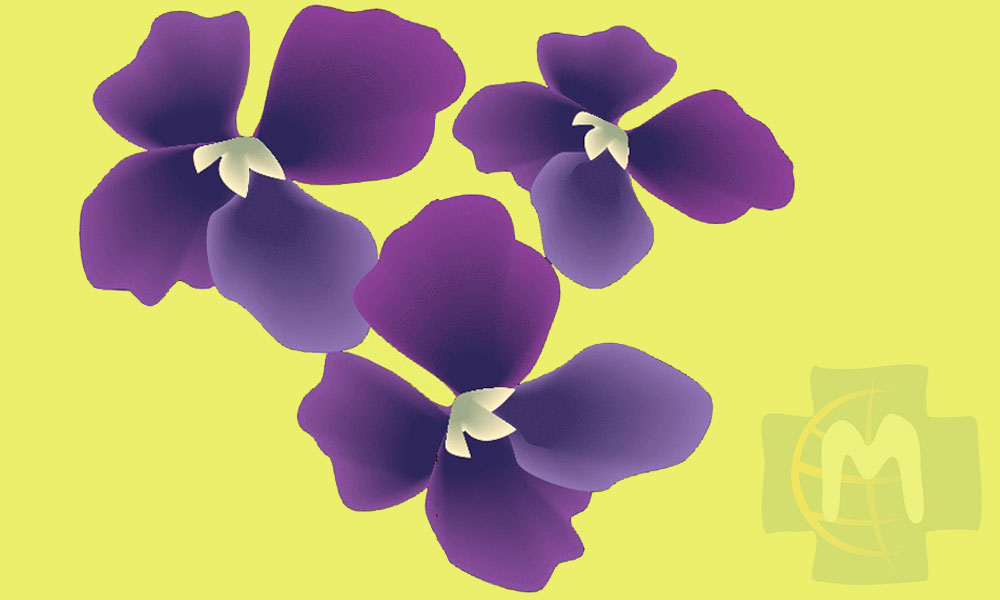
The Three Violets: humility, simplicity and modesty
We all know the three little violets, but what do they signify? From where did the symbol come? Let us take a look at this fundamental Marist symbol.
The idea was in fact Marcellin’s, and it has been part of our Marist tradition from the earliest days. His proposal was that the type of Christian discipleship he wanted Marists to nurture would be underpinned by three basic spiritual attitudes: those of “humility”, “simplicity”, and “modesty”. These are the heart of what it means to be a Marist.
There was nothing novel about his choosing humility as the first of the three. From the times of the desert fathers and mothers, this has always been recognised as the most fundamental and primary disposition for anyone serious about progressing in the spiritual life. It is to recognise God as God. It is to be awestruck, indeed humbled, before the immensity and infinity of God, God’s omnipotence and unfathomable mystery, God’s unshakeable mercy and fidelity. It is to trust in this. The proud don’t know God – they just can’t – the self-righteous, those caught up in their own power and importance, those blind and deaf because they don’t allow themselves to see and hear. The metaphors for the spiritual journey often use terms such as thirst, hunger, yearning, dryness – it is for God they seek, but more importantly, know that they need to seek. Blessed are the poor in spirit, is Jesus’ opening line in Matthew 5, for theirs is the reign of God.
Simplicity was more novel as a spiritual attitude. St Francis de Sales – one of the key sources of Marcellin’s developing spirituality – was someone who emphasised this. It is to be oneself before God – openly, genuinely, trustingly, vulnerably. It is to hide nothing, to pretend nothing, to mask nothing. It is to not kid oneself or presume to trick God. It is to have an uncluttered relationship with God, something direct and transparent like any genuinely loving relationship – one not in need of lots of augmentation, or props, or proofs. No secrets, no game-playing, no hidden agenda. It is to use language and symbols that are accessible, even affective and intimate. Some would say that simplicity is the most quintessential of the Marist traits. Blessed are the pure of heart, for they shall see God.
And modesty. Some people trip up on this because they confuse it with lack of self-assurance or poor self-esteem. Nothing could be more opposite. Modesty is about having a self-concept that is secure and mature enough not to feel any need to intrude or impose myself on another, not to shout them down with my voice, to crowd them with my presence, to use them to satisfy my emotional needs, or to serve my ends. It is rather, to put the other at the centre – respectfully, selflessly, and non-possessively. It is to be focussed on them rather than myself. Where humility is recognising God as God, modesty is allowing God to be God, and to act in my life as God. It is to work to learn about God, to be alert to God’s quiet and subtle presence and movement in my life, and to allow myself to be affected by that, even transformed by it. Blessed are the meek.
One of the greatest mistakes that Marists have made – including among them some of Marcellin’s early Brothers – was to think that humility, simplicity and modesty had something to do with behaviours that straight-jacketed or diminished the full human expression of whom each of us is as a person. Not at all. They are not behavioural guidelines but, rather, spiritual attitudes. Of course, if we nurture them in our faith lives – in the way we approach God – then they are likely to be mirrored in our ministry. That is to say, we will approach young people and our colleagues, and everyone, in the same way that we approach God: with the respect that comes from humility, with the genuineness that comes from simplicity, and with the desire to allow them to shine that comes from our modesty. We approach them with an apron, basin and towel. To love and to serve.
For a symbol to represent all of this, Marcellin turned to the little flowers that grow wild in that part of France. These flowers are not ones that shout out through their colour, their size or their scent: “Look at me! Look at me!” No, they are small – tiny purple flowers scattered in green fields. But when discovered, they can be seen to have their own beauty, their own integrity, and their own quiet statement of who they are. And the fields are different, as a result.
_____________
Br Michael Green
